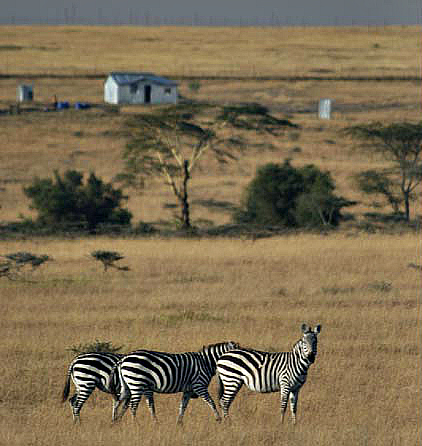
Rangelands outside Nairobi, Kenya (photo credit: ILRI/Mann).
A new paper on the consequences of land fragmentation and fencing on rangelands outside Nairobi, Kenya, formerly rich with wildlife and critical for the functioning of Nairobi’s famed national park, has been published. All of the authors are former staff, and one former partner, of the International Livestock Research Institute (ILRI), where this research work was conducted.
‘. . . [R]elative to other systems, the effects of fragmentation in pastoral savanna ecosystems are still poorly understood (Galvin & Reid, 2007), and little is currently known about the forces driving habitat loss and fragmentation and their ecological and economic consequences to pastoral communities.
Understanding the principal underlying causes and consequences of fragmentation and habitat loss is fundamental to the effective management and conservation of human-dominated ecosystems, including the savannas of East Africa . . . .
‘The arid and semi-arid savannas of East Africa are important areas for pastoralism and are also key areas holding large and diverse populations of wild ungulates. However, most of the areas are now faced with increasing land-use changes, fragmentation and habitat loss due to increasing human population, land tenure changes, land subdivisions, agricultural expansion, urbanization and inappropriate land use policies.
‘The Athi-Kaputiei Plains of Kenya (AKP) represent an extreme case where changes in land tenure, proximity to a major city, urbanization and immigration are causing rapid land use changes in a pastoral savanna and may well represent the future of other, currently less intensely used, pastoral ecosystems in East Africa (Ogutu et al., 2013 and Reid et al., 2008). . . .
The AKP epitomises the type and extent of land use changes occurring across most pastoral lands of East Africa and may, unfortunately, well represent the future state of many pastoral savanna ecosystems in the absence of urgent and effective remedial interventions.
‘Changing land tenure arrangements, lasses-faire land use policies, increasing human population and the associated fences and settlements, urbanization and sedentarization of the formerly semi-nomadic Maasai are adversely impacting wildlife and livestock populations and pastoral wellbeing in AKP, as in other pastoral rangelands of East Africa. . . .
The total wildebeest population exceeded 30,000 animals in the 1970s but had dropped to about 509 animals by 2014. The migratory wildebeest population was virtually exterminated from Triangles I and III where their density dropped by 99–100% in both the sparsely and densely fenced areas between 1977 and 1987 and 1999–2014.
‘Wildebeest populations collapsed to a small fraction of their former abundance due to obstruction of their movements by the fences between Triangles I and II, poaching, habitat degradation and loss to roads, settlements and other developments; exemplified by the rapid expansion of Kitengela town. . . .
‘In conclusion, the Athi-Kaputiei ecosystem of Kenya exemplifies an ecosystem experiencing extreme landscape fragmentation due to expansion of fences, settlements, roads, farms and other developments. The location of this ecosystem so close to a rapidly expanding major city where undeveloped land is becoming increasingly scarce and expensive, has made it a strong magnet for those seeking relatively cheap land for settlement, industrial and other developments. Correspondingly, there is massive expansion in infrastructure supporting the expanding developments and human population.
Wildlife and pastoral livestock are being displaced by these changes and their remaining habitats degraded. The corridors for migratory wildebeest, zebra and eland populations in this ecosystem have either become severely restricted or completely blocked. As a result, the range and population size of the once spectacular wildlife populations in this ecosystem have been dramatically reduced.
‘These processes will continue to endanger both the ecological integrity of the ecosystem and the wildlife and livestock populations that it supports, if no appropriate interventions are instituted immediately. Interventions currently being undertaken to counteract the range contractions and population losses are disjointed, underfunded or too limited in their spatial extents to even save the few remaining critical parts of the ecosystem still supporting wildlife and livestock in the long-term. Establishing a community wildlife conservancy whose status is secured by law would be one potential option for protecting parts of the ecosystem still supporting wildlife. Far-sighted land use plans and faithful implementation of such plans are thus necessary to steer other similar ecosystems away from the trajectory followed by the Athi-Kaputiei ecosystem resulting in its current extreme fragmentation and imminent collapse of its functional integrity.’
The Belgian Government and the United States Agency for International Development (USAID) funded the mapping of fences in the Athi-Kaputiei Plains through grants to the International Livestock Research Institute (ILRI) and the African Wildlife Foundation (AWF).
Read the whole paper:
Effects of extreme land fragmentation on wildlife and livestock population abundance and distribution, by Mohammed Said, Joseph Ogutu, Shem Kifugo, Ogeli Makui, Robin Reid and Jan de Leeuw, Journal for Nature Conservation, Vol 34, Dec 2016, available online 22 Oct 2016. http://dx.doi.org/10.1016/j.jnc.2016.10.005. The following link provides free access to this article until 28 Dec 2016: https://authors.elsevier.com/a/1U0dT_anFkJ2W~
Read about a related scientific paper:
Kenya’s wildlife populations are in ‘widespread’ and ‘catastrophic’ decline—New study, 1 Oct 2016.